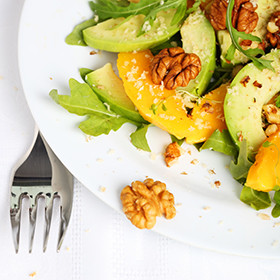Mindless Fat: Packing it On
Todays post is by guest author Veronica Dascalu. This is excellent advice and in line with what I teach my weight clients.
“The best diet is the one you don’t know you’re on,” writes Brian Wansink in his book Mindless Eating. We follow nutrition guidelines, read trendy diet books, and take up the craziest diets to reach one common goal — weight loss. If you ask me, it can be very exhausting, not to mention futile. As much as we try to “watch what we eat,” we eat mindlessly.
Have you ever opened your fridge and grabbed that last piece of lasagna as if were some prized discovery — that dry, crusty, two-day-old lasagna. You did not eat it because you were hungry; you ate it because it was there. How about when you are at the movies, and you are surprised to notice, as the credits roll, that you have finished that entire bucket of popcorn all by yourself.
Mindless eating causes a short circuit in your hunger and taste signals, leading to overeating. Wansink defines what he calls the mindless margin as a zone in which a person can overeat without knowing it. This zone accounts for the mindless extra calories — approximately 300-500 a day — that we consume. It takes 3,500 calories to gain one pound of fat. Eating an extra 300-500 calories a day for a week will provide it. To visualize this ghastly pound, do this: When you are at the store the next time, pick up one pound of hamburger meat, hold it up to your body and multiply that blob by 52 weeks. You have just added 52 new pounds — without even trying.
Recent research states that individuals underestimate their total daily calorie intake by 20-30%. We have difficulty knowing the difference between feeling full and no longer feeling hungry. To accurately record how much we consume, we need to become aware! Here are a few tips:
- Look carefully at what you eat before you eat it. Become aware of the portion size, the environment you are eating in and your emotional state.
- Downsize your plates, bowls and storage containers. Filling up an eight-inch plate with food creates the illusion of volume, an amount that looks ample in comparison to the same amount of food on a twelve-inch plate. Creating the illusion of volume helps control portion size. In some countries, all the plates are saucer-sized! Think tapas.
- Make overeating difficult. Keep tempting foods out of sight. Do not go to the grocery store hungry. If you purchase snacks in boxes or large bags, divide them into smaller bags.
- Be aware of your expectation. Menus are meant to tempt you by making everything sound irresistible. The taste and digestion signals start before you ever order your food. When at a restaurant, look at the appetizers and side dishes first. The portion sizes are usually smaller than the sizes of the entrées, and the descriptions are shorter and simpler.
- Ask yourself this question: What am I hungry for? Is your need for food a response to physical hunger or an emotional need? A physical hunger builds gradually. You feel it in your stomach, and it usually goes away after eating. Emotional hunger comes on suddenly with a feeling of wanting something specific, like chocolate, and it persists after eating. There is no long-term satisfaction or satiety.
Even with all this knowledge, do not deprive yourself of enjoying food. Eating is a pleasure that encompasses all the senses. Allow yourself to feel the fulfillment of feeding your body and keeping it healthy. Treat your body well. It’s the only one you’ve got.
Veronica Dascalu holds a master’s degree in nutrition and dietetics from California State University, Northridge. She is also a certified wellness coach and personal trainer with more than ten years of experience. Emphasizing that no two people have the same metabolic needs, Veronica uses a customized, individual approach to help her clients achieve their nutrition and health goals. She employs a wide range of techniques in her practice, including lifestyle strategies and behavior modification. Contact Veronica at 818 404-9698.
If you liked this post, please leave a comment and/or share it with your social networks.
Your companion on the journey to transformation,
TMan
Ted A. Moreno Personal/Small Business Coach Certified Hypnotherapist www.TedMoreno.comFEEL FREE TO — USE THIS ARTICLE IN YOUR EZINE, WEB SITE OR BLOG. Just let me know that you are, and include the following with it:
Ted A. Moreno is a Certified Hypnotherapist and Success Performance Coach. Ted empowers his clients to transform their lives by helping them reach their goals of success, abundance, personal development, health and happiness. To learn more, visit www.TedMoreno.com/blog




Will definitely heed this advice. Love the pict at the top, too!
Thanks Ted & Veronica! I have referred many of my people to Veronica (including my son) she is great at what she does & yes you are what you eat so don’t be a old crusty lasagna!
Does anyone know if hidden eating is the same thing as mindless eating? Just had that thought running around in my ever seeking mind.
Thx Veronica,
I may be calling you soon.